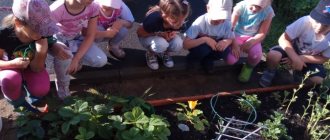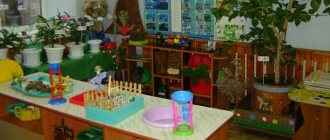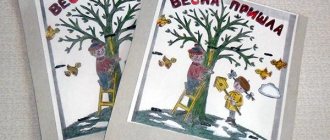“Ecological - health work in preschool educational institutions”
Preschool age is the initial stage of the formation of personal qualities and a person’s holistic orientation. During this period, a positive attitude towards nature, oneself and other people is formed. The foundation of environmental education, undoubtedly, should be laid in preschool age, however, it should not be considered as an isolated area of \u200b\u200bwork in preschool educational institutions. Environmental education has ideological significance, therefore it is necessary to strive for the greening of the entire educational process in preschool educational institutions. This involves close cooperation of all specialists based on an integrated approach to the greening of various activities of preschool children. Integration involves the interpenetration of different types of activities. One of the leading risk factors for children's health is the environmental situation in their places of residence. In this regard, increasing environmental literacy of children, their parents and preschool teachers may be one of the ways to preserve the health of preschoolers. One of the most important tasks of MBDOU “Firefly” is the protection and promotion of children’s health. In this regard, it is relevant to conduct physical education and environmental work, which
based on the integration of cognitive and motor activity, it simultaneously solves the problems of improving the health of children and increasing environmental literacy in them and their parents. Increasing the effectiveness of education of preschool children in the field of physical education and in the field of ecology is possible subject to their integration, which can be achieved through the formation of environmental knowledge in children in the process of physical exercise, as well as the interaction of preschool staff and parents.
Environmental education and physical education have a common goal: understanding the value of life and health, the formation of a personal culture, which involves an integrated solution of the following main tasks:
| Objectives of physical education | Objectives of environmental education |
| 1. To form a conscious attitude towards physical activity in preschoolers based on the development of ideas and knowledge about physical culture. | 1. To develop in preschool children the skills of various activities in nature and the development of environmentally oriented interaction with its objects. |
| 2. Increase the level of physical fitness based on the formation and improvement of motor abilities and skills and the development of motor qualities and abilities. | 2. Help children independently understand processes and phenomena occurring in nature. Learn to conduct your own research into the natural world and summarize the accumulated material. |
| 3. Foster the need for a healthy lifestyle based on the formation of interests and motives for physical education. | 3. Accumulate in children emotional and positive experience of communicating with nature. Teach your child to recognize himself as a part of nature. |
Integrated physical education classes have a generally accepted structure. Thus, observations of natural phenomena and conversations about nature are carried out in the preparatory part of the lesson in combination with walking at a moderate pace along an ecological path, and then physical exercises are used in the generally accepted sequence in accordance with the recommended principles of distribution of physical activity. Physical exercises can precede observations and stories about objects or natural phenomena, carried out in the final part of the lesson when returning to kindergarten; familiarization with various types of gymnastics (breathing, finger, corrective) is also included; teaching children basic self-massage techniques; hardening; prevention of flat feet; improving motor skills; developing endurance through a gradual increase in physical activity; teaching the rules of safe behavior in nature.
In the preparatory part of the lesson, physical exercises can be used (for example, walking combined with running),
then nature observations are carried out in combination with thematic exercises and outdoor games, and finally the lesson ends with either running combined with walking, or observations combined with walking at a moderate pace. Integrative classes, conducted by a physical education instructor together with a teacher, consist of physical exercises, the selection of which is determined by the age and level of physical fitness of the children, as well as the time of year and weather conditions. Along with performing physical exercises during classes, children, under the guidance of a teacher, observe natural phenomena and seasonal changes.
The following types of exercise are usually used:
1. Breathing exercises (“Leaves are rustling”, “Frost”, “Dandelion”, “Rainbow, hug me”, etc.);
2. General developmental exercises (“Falling leaves”, “Catch a snowflake”, “Snowdrop”, “Bells”, etc.);
3. Outdoor games (“Hunting for Arctic fox”, “Migration of birds”, “Ice, wind and frost”, “Polar owl”, “Flowers and breezes”, etc.);
4. Relay races (“Harvest”, “Streams and Lakes”, “Young Tourist Relay”, etc.);
5. Seasonal sports exercises (sledding, skiing, etc.)
The selection of exercises is determined by the topic of the lesson and is interconnected with the content of natural history observations. The formation of initial knowledge about nature is carried out in a playful way, taking into account the age-related psychological characteristics of children: for example, you can use characters - “Lesovichka”, a bear, a bunny “Baba Yaga”, who give children a tour of “their domains”.
Our kindergarten also conducts classes - walks along the ecological health path - the purpose of which is to familiarize children with the norms of behavior in the natural environment, which are elements of ecological culture; Health days with an environmental focus, in the content of which teachers include special tasks that require children to demonstrate knowledge and ideas about nature and the foundations of environmental culture.
Interact with the environment ( forest, plants, river
) and weather and climatic factors
(frost, wind, rain, cold, heat),
preschoolers learn during hikes, excursions, walks, special classes (
gym, sports ground, physical education corners in groups, equipped with various sports equipment)
. At the same time, their horizons expand, moral and volitional qualities are formed (friendship, mutual assistance, initiative, perseverance, endurance, collectivism, etc.), and their health improves.
So, in modern conditions, when the scope of educational influence is significantly expanding, the problem of environmental education of preschool children becomes particularly acute and relevant. At the stage of preschool childhood, an initial sense of the world around us develops: the child receives emotional impressions of nature and accumulates ideas about different forms of life. Thus, already during this period the fundamental principles of ecological thinking, consciousness, and ecological culture are formed. But only under one condition - if the adults raising the child themselves have an ecological culture: they understand the problems common to all people and are concerned about them, show the little person the beautiful world of nature, help the little person the beautiful world of nature, help establish relationships with him.
In our work with children on their environmental education, an integrated approach is widely used, which involves the interrelation of various types of activities - physical education, music, visual arts, games, theatrical activities, excursions, as well as the organization of independent activities of children. Increasing the effectiveness of education of preschool children in the field of physical education and in the field of ecology is possible subject to their integration, which can be achieved through the formation of environmental knowledge in children in the process of physical exercise, as well as the interaction of preschool staff and parents. At the same time, their horizons expand, moral and volitional qualities are formed (friendship, mutual assistance, initiative, perseverance, endurance, collectivism, etc.),
health improves. The ecological and developmental environment in our kindergarten is aimed at developing elements of environmental culture and competent behavior of children in nature, allowing for the implementation of all components of the content of environmental education, development and education of preschool children.
Nature has made sure that its inhabitants have everything they need for a full life and know how to take care of their health. It is easier to protect and improve health from the moment of birth than to treat diseases afterward. To maintain your health, you must protect the “health” of the surrounding nature. We are confident that it is possible to preserve and increase it for future generations through a conscious, careful and positive attitude, through the formation of a stable position of citizens on these issues.





